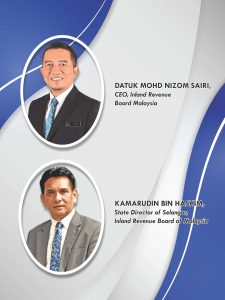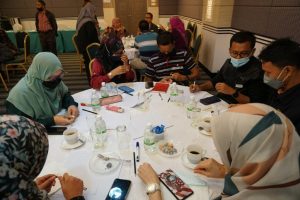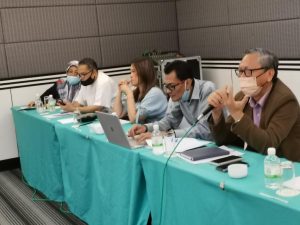

Datuk Mohd. Nizom Sairi, CEO, Inland Revenue Board of Malaysia
Kamarudin Bin Hashim, State Director of Selangor, Inland Revenue Board of Malaysia
Datuk Prof. Dr Leow Chee Seng, Advisor, Humanology Sdn Bhd

Introduction
Numerous firms are attempting to combat the “disengagement virus” with a variety of activities and benefits; however, these initiatives and rewards have been shown to have little or no long-term impact on employee engagement.
Every organisation that is savvy enough to really care about its people’s happiness and engagement, and smart enough to see that this is critical to their commercial success, deserves to be applauded for their efforts. However, studies have revealed that most businesses are falling short of their goals and are focusing their efforts on “putting lipstick on a pig” rather than implementing the systemic and cultural reforms that are necessary for long-term success.
Employee disengagement appears to be viewed as an issue by many organisations as if disengaged individuals have decided to be dissatisfied and angry in the first place. Employees who are disengaged out of spite, on the other hand, are extremely rare.
There is a disconnect between them and their work since they are working in an environment where they do not feel appreciated, respected, or valued. It’s because management treats employees as if they’re just numbers, expenses, or resources rather than as people who ought to be treated with dignity and respect.
This is because they are unable to be themselves, they do not feel safe in their surroundings and they are frightened of making mistakes. It’s a survival mechanism for many people, and it’s a method to get through the workday without jeopardising their job or their soul in the process.

Essential Skills of Leadership
A leader should develop skills in planning, monitoring, controlling, and acting or executing. Throughout the planning process, the leader must be very clear about the output and expected outcomes.
During the planning stage, a variety of techniques can be utilised to analyse the issues. Several popular techniques include SWOT analysis, Ishikawa fishbone analysis, and Pareto analysis. When conducting environmental assessments, leaders must be capable of doing environmental scanning, forecasting, benchmarking, budgeting, scheduling, breakeven analysis, and linear programming. In terms of contemporary planning, the leader must possess the ability to manage projects and develop scenarios. As such, it is obvious that the leader must assess all risks and probable outcomes before conducting a programme. As such, the leader must develop time management skills in order to successfully complete the programme.

Making decisions is another critical talent that the leader must develop. They must be accountable for their actions and accept responsibility for them. Not only must leaders make decisions, but they must also make them quickly and accurately. Analysis skills are critical for decision support.
The Humane Leadership
What the corporate world requires are humane leaders who recognise the new reality of the twenty-first century and recognise that their primary responsibility is to inspire, empower, and trust their people; to create psychologically safe work environments in which they can learn, grow, and thrive, enjoy their work, and be inspired to give their best.
There is a correlation between great leaders’ eagerness to learn and grow – and their ability to foster corporate cultures that encourage and enable others to do the same. When we know better, we owe it to ourselves to act better.

Carol Dweck, a psychologist, discusses two diametrically opposed mindsets in her book Mindset: growth and fixed mindsets. Individuals with a fixed mindset believe their talents, abilities, and intelligence are fixed; they are a finite resources that cannot be modified. Individuals with growth mindsets believe their talents, abilities, and intelligence are malleable and can be developed, as well as their capacity for learning, growth, and change.
What you believe manifests itself in your world. Selecting a development mindset and believing in your capacity for change is the first step in developing into the leader you desire.

Schedule time for self-reflection.
“A life that is not scrutinised is not worth living,” Socrates stated. Reflecting on who we are and whom we aspire to be is critical for learning, growing, and changing in the correct direction. Reflecting on our own beliefs, thoughts, mindsets, and behaviours, as well as how they manifest in our actions, is a necessary component of becoming a self-aware leader. Whether we like it or not, our inner reality is perpetually reflected on the outside.
Schedule some ‘white space’ in your calendar for reflection, reading, learning, unlearning, and relearning. Consider your choices and priorities, compare them to what you believe in and value, and then consider what you may do differently to demonstrate your leadership potential.

Recruit a mentor
Once you’ve established that you can change and defined the type of leader you want to be, team up with an ally, a friend, or a mentor who will be responsible for keeping you on track, assisting you in remaining focused, and holding you accountable for the changes you commit to, as well as providing real-time feedback on progress – or lack thereof.
A good mentor is someone who genuinely wants to see you succeed by listening to you, challenging your thinking, assisting you in growing and developing, and providing you with candid feedback when necessary. Additionally, great mentors freely share their own experiences and failings, allowing you to learn from them as well. Mentors can be obtained both within and outside your organisation and may take the form of a coach, a leader, or a close friend. Simply choose someone who has your best interests at heart.

Have faith in the Butterfly Effect
“Does a butterfly’s wing flap in Brazil trigger a tornado in Texas?” Nearly 45 years ago, Edward N. Lorenz, a mathematician, meteorologist, and professor at MIT, posed this question. Lorenz is best recognised as the originator of modern chaos theory, which was followed by the butterfly effect; the concept that little changes can have a tremendous impact. His research established that seemingly insignificant causes can have far-reaching consequences and that the same principle can be applied to human behaviour and leadership as well.
Small behavioural adjustments can have a huge effect on the people you lead, their work, and the results they produce. The leader’s shadow is considerably longer than you believe. People will replicate what they see; and will act similarly to what you do. Small gestures, such as a smile, a nice word, or some insightful comments, have a lot greater impact than you might believe. Be mindful of what you say and do to ensure that you achieve the desired ripple effects.
Accept the adventure and savour the voyage
Bear in mind that change does not occur instantly. Progress is rarely linear. Rather than that, consider change as a roller coaster ride that includes ups and downs, twists and turns, and unexpected experiences. At times, it’s enjoyable; at others, it’s terrifying. However, the journey is entirely worthwhile. “Just when the caterpillar believed the world had ended, it transformed into a butterfly,” wrote Chinese philosopher Zhuang Zhou. We shall do better now that we are aware. And others will follow suit.
Leadership Toolbox
Nurturing future leaders is most effectively accomplished through a comprehensive training programme that touches the leader’s heart and soul. The approach begins by establishing a baseline of understanding. The future leader will develop talents such as creative thinking, thinking beyond the box, and stepping outside of his or her comfort zone in this part.

The leader would then delve into an examination of the team dynamic. They would have a firm grasp on their own identity and their function within the group. The prospective leaders would then begin to develop an understanding of teamwork. The structural teamwork principle, planning and objective setting, transforming the impossibly into the possible, and self-control are among the subjects that will be explored. Following the completion of all theoretical lecture sessions, the leaders participate in a variety of simulation games that focus on concepts such as efficiency and decision-making. The training concludes with a self-reflection exercise designed to assist the leader in self-reflection.
Conclusion
To nurture future leaders, we must apply passion and compassion. What looked futuristic only a decade ago has become a very plausible possibility. Additionally, continued digital upheaval, uncertain outcomes from key political elections, and greater global volatility as a result of trade conflicts and Brexit provide a climate conducive to learning how to thrive for current and future leaders. To be successful leaders in today’s VUCA (volatility, uncertainty, complexity, and ambiguity) world, leaders must have encountered several diverse difficulties and worked in a variety of jobs.
To move forward always take one step behind so that you can “Muhasabah diri”, look at the historical factor and you vision will be more clearer and the window view become larger.

